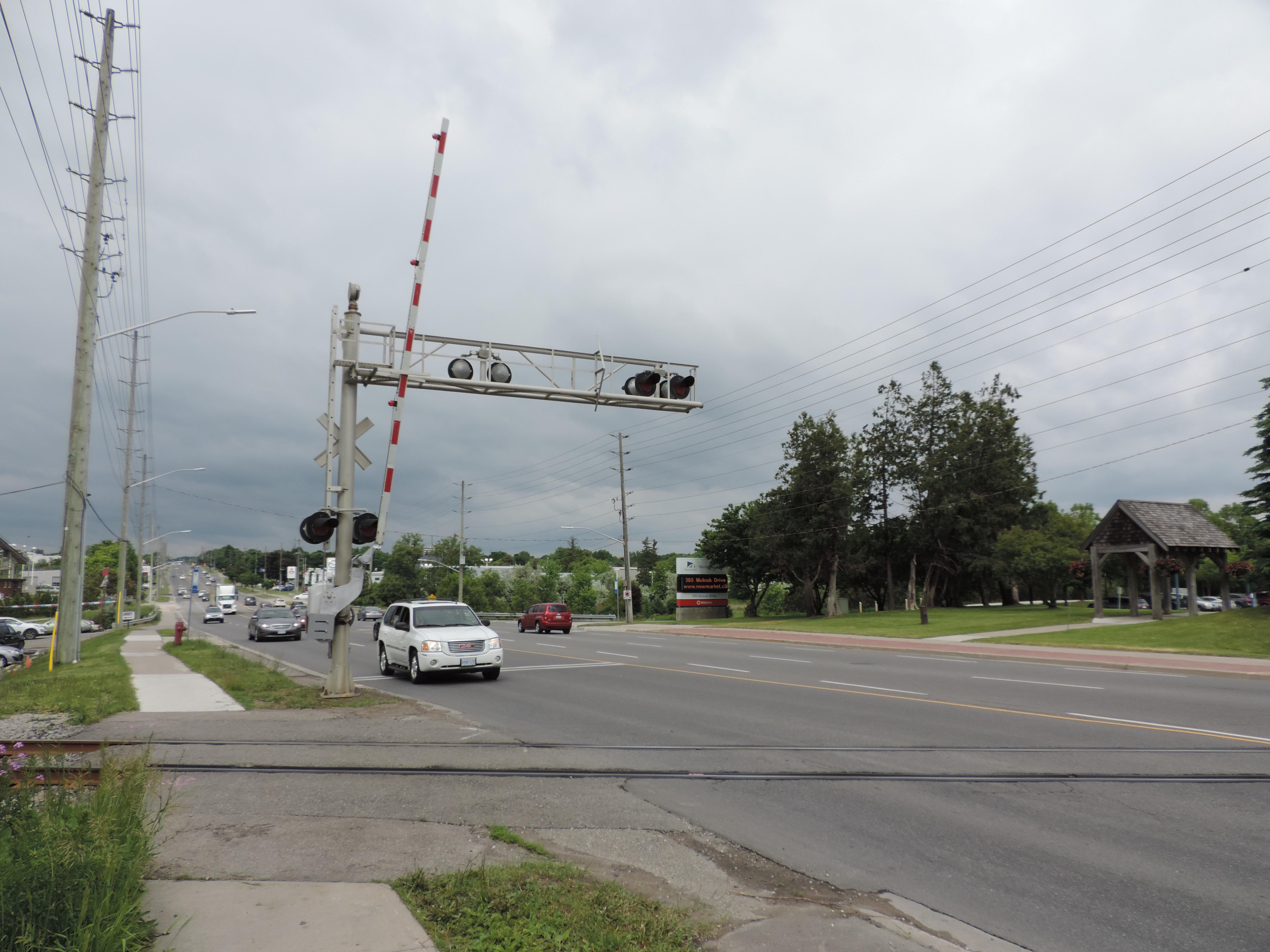- Details
- Written by Gordon Prentice
I have been following the municipal career of Mayor Tony Van Bynen long enough to know he talks the talk but doesn’t always walk the walk. 
The secretive retired banker says he wants to reform the OMB but what has he actually done to advance the cause? With the Province’s review of the OMB underway, now is the time to find out.
After spending $588,291 going to the OMB “to fight for Glenway” – and failing - he vowed he would work with others to bring real change to the municipal planning process.
Before the 2014 municipal election Van Bynen promised voters he would be:
“Bringing real change to the Ontario Municipal Board and the planning process.”
He pledged:
"Bringing reform to the Ontario Municipal Board and the Planning Act to ensure our residents have a say in shaping their community will be a priority in the next term. Our Council’s decision to fight for Glenway and defend our Town’s official plan was the right thing to do. I will be working with the Association of Municipalities of Ontario and a number of mayors to meet with the Province to bring about real change to the municipal planning process.” (see note 2 below)
Promising the earth, delivering dust
So has Van Bynen delivered on his promise to voters?
I formally asked the Town if the Mayor had requested a meeting with the Province to discuss OMB reform at any time since the last election in 2014. I also asked for sight of any correspondence from Van Bynen to the Association of Municipalities of Ontario or to any of the Mayors of its 444 member municipalities on OMB reform from between October 28, 2014 to September 8, 2016. Town staff reported:
“We have conducted a search of our records and have not found any records that specifically indicate that Mayor Van Bynen has requested a meeting with the Province regarding OMB Reform or correspondence sent to AMO or its members on this topic.”
Maybe it was all done by word of mouth.
Maybe there is a mountain of evidence somewhere showing he has been closely engaged in the issue for years but I haven’t found it yet.
Maybe I am doing Tony Van Bynen a terrible disservice and he has been a prime mover, diligently working behind the scenes to advance his OMB Reform agenda
“to give residents a say in shaping their community”.
There has been at least one meeting, maybe more, with Chris Ballard. I don’t know who asked for it yet. But if it was Van Bynen – and we shall find out soon enough - it would be wildly out of character.
In fact, Van Bynen ceded leadership on OMB reform to Aurora whose energetic councillor, Tom Mrakas, organized a municipal summit on the issue earlier this year. Mrakas’ initiative was enthusiastically supported by Ward 7’s Christina Bisanz, a Glenway resident herself.
Van Bynen and the Clock Tower
As is the way of the man, Van Bynen kept what he learned from the Glenway debacle to himself except for this gem that slipped out when he was talking about the Clock Tower development:
“We’ve learned through Glenway that polarity doesn’t help anybody.”
Translated, this means Van Bynen doesn’t like saying no to developers even if it means ripping up the Town’s Heritage Conservation District policy.
“I’m optimistic we can make the Clock Tower work; there may need to be some fine tuning on how we get there.”
Van Bynen, intensification junkie that he is, desperately wants to help Bob Forrest get the go-ahead for his seven storey condo.
But if the Council, led by the Mayor, votes in favour of Forrest’s planning application the decision will be appealed to the OMB by the Newmarket Branch of the Architectural Conservancy of Ontario and other concerned residents.
As Van Bynen might have said, but didn’t…
Defending the Town’s Heritage Conservation District policy is the right thing to do.
This email address is being protected from spambots. You need JavaScript enabled to view it.
(Note 1) Disclosed following a request under the Municipal Freedom of Information and Protection of Privacy Act for access to:
“A record indicating if at any time since October 28, 2014 the Mayor has requested a meeting with the Province to discuss OMB reform and, if so, to provide dates and details. Correspondence from the Mayor to the Association of Municipalities of Ontario or to the Mayors of its member municipalities on OMB reform from October 28, 2014 to September 8, 2016.”
On 22 January 2015, Van Bynen passed on to Chris Ballard various reports that had been prepared by the Town and York Region on OMB reform. This was a follow-up to a meeting between Chris Ballard and Tony Van Bynen and the Town’s Chief Administrative Officer Bob Shelton.
On 28 August 2015, Van Bynen passes on to Chris Ballard a letter from the AMO.
On 14 July 2016, the Mayor’s assistant, Pat Noble, on behalf of the Mayor, passes on to Council colleagues a letter from the Minister on the OMB Review.
In all, there are six records. Details of three other records (listed below) cannot be disclosed until the third parties mentioned give their consent. “These third parties have until 27 October 2016 to provide comment regarding the release of the records.”
There are two emails from Chris Ballard MPP to the Mayor, dated 5 March and 28 August 2015. The former concerns “planning reforms” and the latter is an “update on Bill 73”.
On 28 August 2016, the Mayor received an email from the Ministry of Municipal Affairs and Housing on the subject: “March GTHA Summit Summary Notes”. (Greater Toronto and Hamilton Area Mayors’ and Chairs’ Summit)
You can read the documentation here.
(Note 2) Newmarket’s Director of Planning, the ineffectual Rick Nethery, subsequently contradicted Van Bynen by saying the Town did not go to the OMB to “defend the Town’s Official Plan”.
Update on 12 October 2016: I asked the Town who organised the meeting referred to above. I am told
"it was one of the quarterly meetings with Chris Ballard organised and initiated by the Mayor's Office".
The email continued:
"The Mayor and CAO often attend these meetings together to discuss various matters."
- Details
- Written by Gordon Prentice
A Town Hall on OMB reform will be held at Trinity United Church, 461 Park Avenue, Newmarket from 6pm – 9.30pm on Tuesday 18 October 2016. 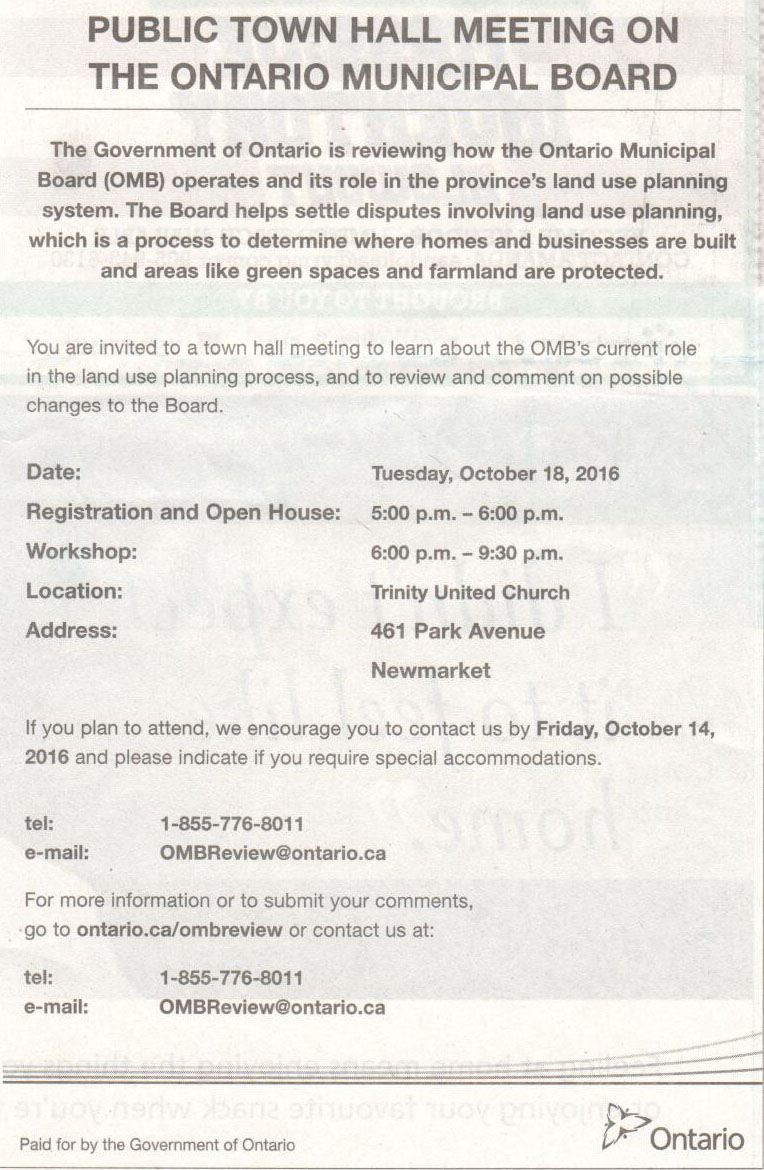
This is a great opportunity to help shape Provincial policy on the future of an appeals body that is never far from controversy.
The Minister of Municipal Affairs, Bill Mauro, says the Government will not be scrapping the OMB but
“We are going to try as best we’re able, through the proposed changes that we’re putting forward, to show more deference for local municipal decision-making.”
You can read the consultation report here.
Who should go?
1. The Mayor, Tony Van Bynen, who, before the last municipal election in 2014, promised Newmarket voters:
“Bringing reform to the Ontario Municipal Board and the Planning Act to ensure our residents have a say in shaping their community will be a priority in the next term. Our Council’s decision to fight for Glenway and defend our Town’s official plan was the right thing to do. I will be working with the Association of Municipalities of Ontario and a number of mayors to meet with the Province to bring about real change to the municipal planning process.”
2. Councillors (if possible - after the Committee of the Whole 7pm session ends) and wannabe councillors.
3. People living in Glenway who were burned by the OMB’s decision and whose neighbourhood is now being utterly transformed.
4. The Town’s Director of Planning, Rick Nethery, who, with his staff, boycotted the Glenway OMB Hearing
5. People concerned about the proposed 7 storey Clock Tower development and the developer’s appeal to the OMB.
6. Anyone else who believes local democracy and good planning are being subverted by the OMB.
More to come on this.
This email address is being protected from spambots. You need JavaScript enabled to view it.
- Details
- Written by Gordon Prentice
The promised new GO Rail Station on Mulock will only go ahead if the Town commits itself to high density development in the area according to Metrolinx - the agency responsible for delivering Regional Express Rail.
This means a new Secondary Plan for the Mulock area with work starting in 2017.
I support the new GO Rail station at Mulock for a thousand reasons (which I needn’t go into here) but, inevitably, it will mean major intensification along Mulock Drive. Already, the so called “centres and corridors” program on Davis and Yonge will bring another 32,000 people to the Town. The development of Mulock will add to this number.
Intensification in the old downtown not needed to meet targets
The Mayor is constantly banging on about “intensification”. He positively salivates at the prospect of more “intensification” in the old downtown. But, at the risk of stating the obvious, the Clock Tower is not needed for us to meet Provincially mandated intensification targets. (By the way, Glenway wasn’t either.)
A report that went before York Region’s Committee of the Whole today tells us
“The Town of Newmarket is evaluating transportation and land use policies to advance planning work for the Mulock GO station. It is anticipated that Secondary Plan studies will proceed for the Mulock GO station in 2017.”
and
“Expansion of the GO transit network and introduction of new GO stations has the ability to transform local communities by attracting transit-oriented, mixed use, high density development.”
The Chief Executive of Metrolinx, Bruce McQuaig, wrote to the Town’s CAO, Bob Shelton, on 4 August 2016 confirming that a new station at Mulock had been recommended as part of the GO Regional Express Rail 10 year program. (see page 133 in the York Region report.)
But McQuaig warns:
“Please note that the new station is still subject to further detailed analysis and conditions to address contextual issues.”
Metrolinx wants Newmarket to give a commitment by 30 November 2016 that it will implement
“transit supportive planning regimes around the station if such does not already exist.”
The next steps will involve reviewing
“the current land use policies in the Mulock station area and update as necessary any local policies, guidelines or by-laws to ensure transit supportive uses.”
Our Mayor, Tony Van Trappist, snoozes through this agenda item – one of the biggest issues facing the Town in a generation. It is left to the Deputy Sheriff, John Taylor, to ask some probing questions about why Aurora is getting the gold-plated all-day two-way 15 minute service when Newmarket collects the silver medal with a 30 minute service. It is, of course, better than what we have at the moment but it is still not good enough.
Taylor asks Stephen Collins, York Region’s acting Commissioner for Transportation, why the 15 minute service can’t be extended northwards to Mulock. Newmarket is a designated place to grow. Taylor says the 15 minute cut-off point at Aurora was decided before the decision was taken to have a new station at Mulock.
Collins, poker faced, says the decision has been taken and, so far as Metrolinx staff are concerned, it won’t be revisited.
We shall see.
A report is going to Newmarket’s Committee of the Whole on 18 October 2016.
This email address is being protected from spambots. You need JavaScript enabled to view it.
- Details
- Written by Gordon Prentice
Clock Tower developer Bob Forrest told the OMB last year that Newmarket Council was “dysfunctional” and “difficult to work with”.
He told the OMB last December that he expected the Town to agree a new Zoning By-law which would allow him to go to seven storeys and that his OMB appeal would be withdrawn.* 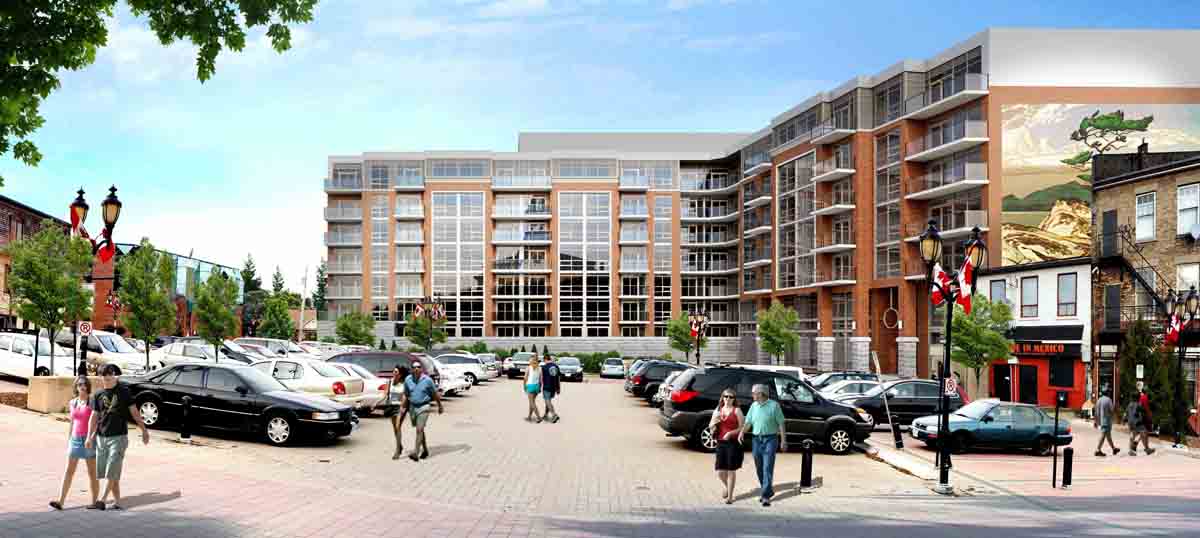
Forrest lodged an appeal with the OMB in November 2013 asking that his properties at the Clock Tower should be exempt from the Heritage Conservation District by-law 2013-51 on the grounds that his planning application was lodged with the Town on 23 August 2013 - before the by-law was enacted on 21 October 2013.
Forrest’s lawyer, Ira Kagan, told the Town Clerk, Andrew Brouwer, on 29 November 2013:
“Our clients take the position that their redevelopment should be judged against the policy regime in place at the time of their application and that their redevelopment application should not be subject to Part V of the Ontario Heritage Act. Accordingly, our client appeals By-law 2013-51 insofar as it applies to the proposed development.”
The OMB ruled that the HCD By-law should come into effect on 21 October 2013 but that the Forrest lands at 180-194 should be exempt, pro tem, pending a decision by Newmarket Council on the Clock Tower application.
Since then there has been much back and forth between Forrest and the OMB.
Dysfunctional and difficult to work with
In a letter to the OMB dated 14 April 2015 Forrest wrote:
“When last you were provided an update on this project, we indicated that we were still seeking an investment partner for the site, and that additionally we had negotiated with the Town a revised scope of our appeal to only be applicable to our properties located between 180-194 Main Street South in Newmarket.
I would like to take this opportunity to expand upon the current status of the project. When this appeal was initiated, the Council of the Town of Newmarket was dysfunctional and difficult to work with. As such it caused us to delay continuation of work from our side, until a new Council was voted in during the municipal elections that were held in November 2014.
Since the election, we have been in negotiations with Town Councillors and Staff to arrive at a negotiated resolution that would avoid the need for a full hearing before the OMB, and instead allow for just a settlement hearing and the Board to approve our negotiated resolution.
We are currently expecting these negotiations to be concluded within two (2) to four (4) months with the Town. We will undertake to provide you with monthly updates on the status of those negotiations, but please rest assured that it (is) out intent to resolve this matter and bring it before the Board for your approval, as quickly as possible.”
Kind Regards
Bob Forrest
Secretary (Main Street Clock Inc) 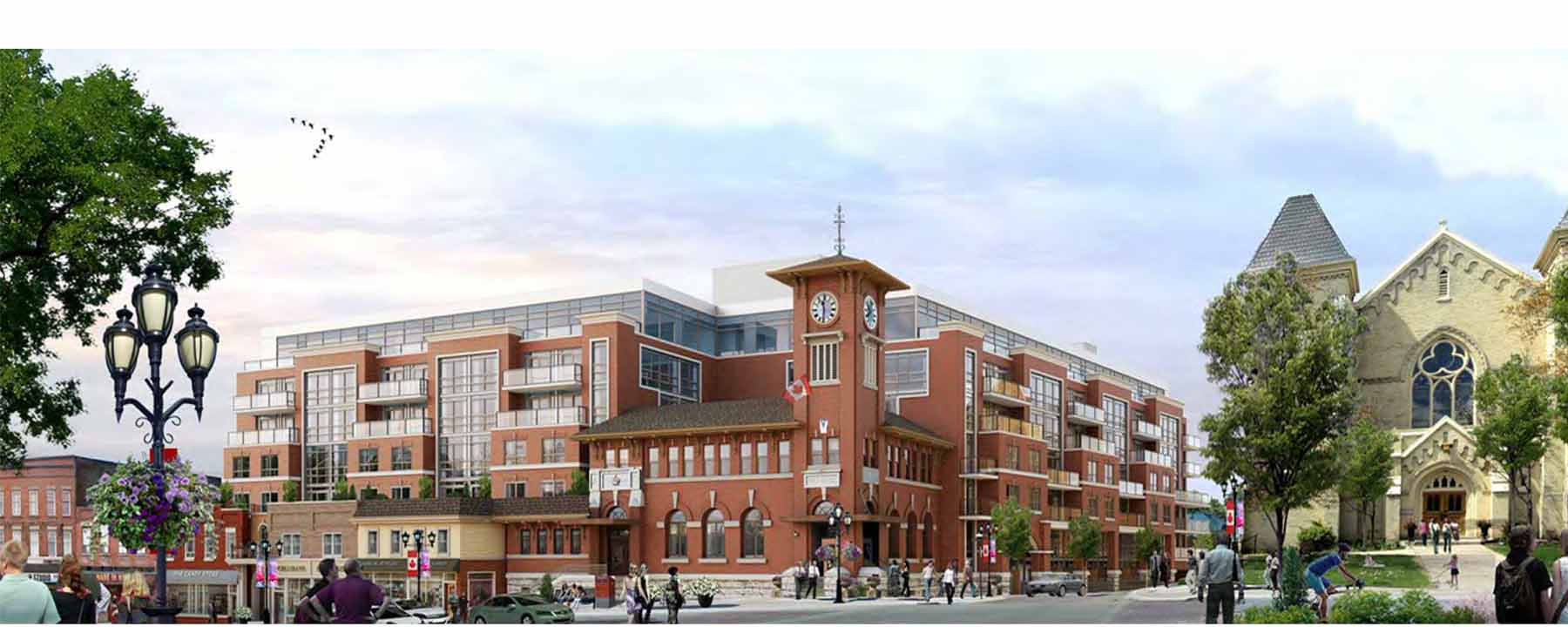
The Town is likely to settle
On 2 December 2015, Forrest told the OMB that it looked as if the Town would settle on his terms and that the appeal would be withdrawn:
“Neil has moved to California so I will be your contact henceforth.
I believe you know that we have an application before the Town for a 9 storey (on Park) and 3 storey (on Main) building on the site.
There have been extensive discussions which, just now, seem to be resolving with an amendment to a 7 storey building stepped back from a two storey podium on Main Street.
In the course of discussions, it appears that there will be an appetite for both parties to ask for the appeal to be removed in concert with a new Zoning by-law being enacted.
Given the season, I expect it will be February before our amended application is granted a complete letter.
May I suggest that I schedule to provide you with an update at the end of February?
Best… Bob
Negotiated resolution
On 16 February 2016, Forrest was talking about a negotiated resolution:
“We have amended our application to 2 storeys on Main Street, stepping back to 7 storeys behind and on Park.
Presently we are awaiting feedback, but we have discussed with the Town a negotiated resolution to the OMB matter in the course of Zoning being granted.
We will diarize to get back to you in another three months, by which time we should know where we are going.
I hope this will work for you.
Best… Bob
A new zoning by-law - drafted by Forrest!
On 4 May 2016, Forrest told the OMB he hoped to get his new zoning and the matter could be put to rest:
“It is my hope that we will soon secure our Zoning, whereupon there will be a negotiation with the Town that will result in our jointly returning to the Board, to put this matter to rest.
My version, as described above, is probably a little simpler than what will really happen but that is the game plan.
I hope this brings you to current status.
With your agreement, we will diarize to be back to you again in three months time… with good news, I hope.
Best….. Bob
On 2 August 2016, Forrest told the OMB the finishing post was in sight:
“The Clock Tower project is on the agenda for the Newmarket council meeting on Monday August 29, 2016.
The public meeting occurred as planned on Monday May 9, 2016.
I will be back to you after the August meeting with an update.
Best…. Bob
Spanner in the works
The unexpected resignation of Joe Sponga threw a spanner in the works. The much anticipated report from the Town’s planners on Forrest’s Clock Tower application was postponed until after the Ward 5 by-election on 17 October 2016.
Throughout this long saga, Forrest sought to spoon feed the Town, even drafting a new Town by-law which would allow the development to get off the ground. He has relentlessly courted councillors over coffee in Tim Hortons and elsewhere.
Clearly, Ward 5 needs to elect a new councillor who will not be a patsy. Someone who will stand up to the Project’s cheerleader-in-chief – Mayor Tony Van Bynen who supports the “concept and the principle” of dumping a huge 7 storey apartment building in the middle of the Town’s priceless Heritage Conservation District.
As Forrest says, we need to put this to rest once and for all.
This email address is being protected from spambots. You need JavaScript enabled to view it.
*The proposed new by-law allowing the construction of 7 storeys on the Clock Tower site is set out in Forrest’s Planning Justification Report of January 2016 which you can read here. At page 33 it says:
“A draft Zoning By-law Amendment has been prepared and submitted to consolidate zoning on the property and to seek relief of the above noted provisions in order to implement the Proposal… A copy of the draft Zoning By-law Amendment is attached as Appendix B for reference.”
- Details
- Written by Gordon Prentice
Last night’s candidates Q&A, hosted by the Newmarket Chamber of Commerce, is great free entertainment but it is also revealing. Everyone is on their best behaviour – including the moderator, Steve Hinder, who is enthusiastically in favour of the proposed Clock Tower development but doesn’t let his bias show and handles things well. 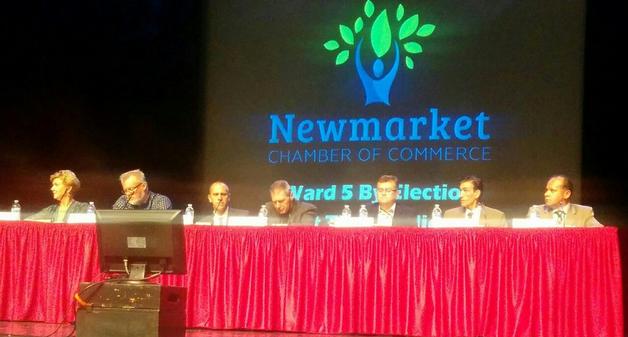
Given their views on the Clock Tower, Ian Johnston and Tom Pearson can be immediately discounted. They are not serious contenders.
Tracee Chambers is against. She believes the Heritage By-law should be respected. She wants a master plan for the old downtown.
Ron Eibel is against. He insists on a strict three storey height cap.
Peter Geibel is against. He wants to move Forrest’s condo from Main Street to the tennis courts. Intensification is needed but it should go where it belongs.
Ian Johnston is for. He is all over the place before concluding that Forrest’s Clock Tower is needed.
Tom Pearson is for. He says it is not going away. He says anyone who believes that is dreaming in technicolour.
Bob Kwapis is against 7 storeys but, other than that, it is open for discussion.
Darryl Wolk is against. He is very firm on the three storey limit. He says the By-law must be respected.
Apart from the two outliers, Johnston and Pearson, the former often incoherent and the latter credulous, a clear majority of the candidates reject Mayor Tony Van Bynen’s view that the Clock Tower “is a great example of the intensification we need”.
This email address is being protected from spambots. You need JavaScript enabled to view it.
Page 193 of 286
